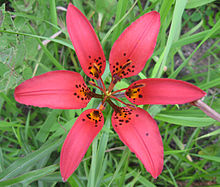Lilium philadelphicum
| Lilium philadelphicum | |
|---|---|

| |
| Scientific classification | |
| Kingdom: | Plantae |
| Clade: | Tracheophytes |
| Clade: | Angiosperms |
| Clade: | Monocots |
| Order: | Liliales |
| Family: | Liliaceae |
| Subfamily: | Lilioideae |
| Tribe: | Lilieae |
| Genus: | Lilium |
| Species: | L. philadelphicum
|
| Binomial name | |
| Lilium philadelphicum | |
| Synonyms[1] | |
| |
Lilium philadelphicum, also known as the wood lily,[2] flame lily,[3] Philadelphia lily, prairie lily, or western red lily, is a perennial species of lily native to North America.
Distribution
[edit]The plant is widely distributed in much of Canada from British Columbia to Quebec, and parts of the United States (Northeast and Great Lakes regions plus the Rocky and Appalachian Mountains).[4][5]
Description
[edit]Lilium philadelphicum grows to a height of approximately 30 to 90 centimeters. It produces red or orange blooms between June and August.[6]
Varieties
[edit]- Lilium philadelphicum var. andinum—western wood lily, native to Midwestern U.S., Great Plains, and Western U.S. regions.[7] It is the floral emblem of the province of Saskatchewan in Canada, and is on the flag of Saskatchewan.[8][9][10]
Conservation
[edit]Lilium philadelphicum is listed as an endangered species in Maryland, New Mexico, Tennessee and North Carolina.[4][11] Its status is a threatened species in Kentucky and Ohio.[4]
As the Saskatchewan provincial floral emblem, it is protected under the Provincial Emblems and Honours Act, and cannot be picked, uprooted or destroyed in any manner.[9][8]
Toxicity
[edit]Cats are extremely sensitive to lily toxicity and ingestion is often fatal.[12][13][14] Households and gardens that are visited by cats are strongly advised against keeping this plant or placing dried flowers where a cat may brush against them and become dusted with pollen that they then consume while cleaning. Suspected cases require urgent veterinary attention.[15]
Rapid treatment with activated charcoal and/or induced vomiting can reduce the amount of toxin absorbed (this is time-sensitive so in some cases, vets may advise doing it at home), and large amounts of fluid by IV can reduce damage to kidneys to increase the chances of survival.[15]
Traditional uses
[edit]The bulbs were eaten by some Native Americans.[16]
Gallery
[edit]-
Flower with foliage
-
Side view of flower
-
Immature flower
-
Rare yellow form in Logan County, North Dakota, USA
-
Exhibit at Callaway Gardens
References
[edit]- ^ Kew World Checklist of Selected Plant Families
- ^ Skinner, Mark W. (2002). "Lilium philadelphicum". In Flora of North America Editorial Committee (ed.). Flora of North America North of Mexico (FNA). Vol. 26. New York and Oxford: Oxford University Press – via eFloras.org, Missouri Botanical Garden, St. Louis, MO & Harvard University Herbaria, Cambridge, MA.
- ^ "Lilium philadelphicum". Germplasm Resources Information Network. Agricultural Research Service, United States Department of Agriculture. Retrieved 2024-05-13.
- ^ a b c NRCS. "Lilium philadelphicum". PLANTS Database. United States Department of Agriculture (USDA). Retrieved 24 May 2016.
- ^ "Lilium philadelphicum". County-level distribution map from the North American Plant Atlas (NAPA). Biota of North America Program (BONAP). 2014.
- ^ "Plant detail: Lilium philadelphicum". Evergreen. 2008. Retrieved 2008-07-09.
- ^ "Lilium philadelphicum". Native Plant Database. Lady Bird Johnson Wildflower Center, University of Texas at Austin.
- ^ a b "Government House Gardens Showcase Western Red Lily". Government of Saskatchewan. 2005-07-21. Archived from the original on 2011-06-11. Retrieved 2008-07-09.
- ^ a b "Saskatchewan's Provincial Flower". Government of Saskatchewan. Retrieved 2008-07-09., designated in 1941.
- ^ "Saskatchewan". Government of Canada. 2013-08-20. Retrieved 2015-07-18.
- ^ "Endangered Plants of North Carolina". North Carolina Natural. February 2000. Retrieved 2008-07-09.
- ^ Frequently Asked Questions No Lilies For Cats.
- ^ Fitzgerald, KT (2010). "Lily toxicity in the cat". Top Companion Anim Med. 25 (4): 213–7. doi:10.1053/j.tcam.2010.09.006. PMID 21147474.
- ^ Lilies Pet Poison Helpline.
- ^ a b Lily Poisoning in Cats. Pet MD.
- ^ Niering, William A.; Olmstead, Nancy C. (1985) [1979]. The Audubon Society Field Guide to North American Wildflowers, Eastern Region. Knopf. p. 602. ISBN 0-394-50432-1.
External links
[edit]![]() Media related to Lilium philadelphicum at Wikimedia Commons
Media related to Lilium philadelphicum at Wikimedia Commons
- Lilium
- Flora of Canada
- Flora of Western Canada
- Flora of the Northeastern United States
- Flora of the North-Central United States
- Flora of the South-Central United States
- Flora of Alabama
- Flora of Arkansas
- Flora of Colorado
- Flora of Delaware
- Flora of Georgia (U.S. state)
- Flora of Kentucky
- Flora of Maryland
- Flora of North Carolina
- Flora of Ontario
- Flora of Quebec
- Flora of South Carolina
- Flora of Tennessee
- Flora of Virginia
- Flora of Washington, D.C.
- Flora of Wyoming
- Flora of the United States
- Flora of the Appalachian Mountains
- Flora of the Great Lakes region (North America)
- Flora of the Rocky Mountains
- Plants used in traditional Native American medicine
- Plants described in 1762
- Taxa named by Carl Linnaeus
- Endangered flora of the United States
- Provincial symbols of Saskatchewan
- Liliales stubs





